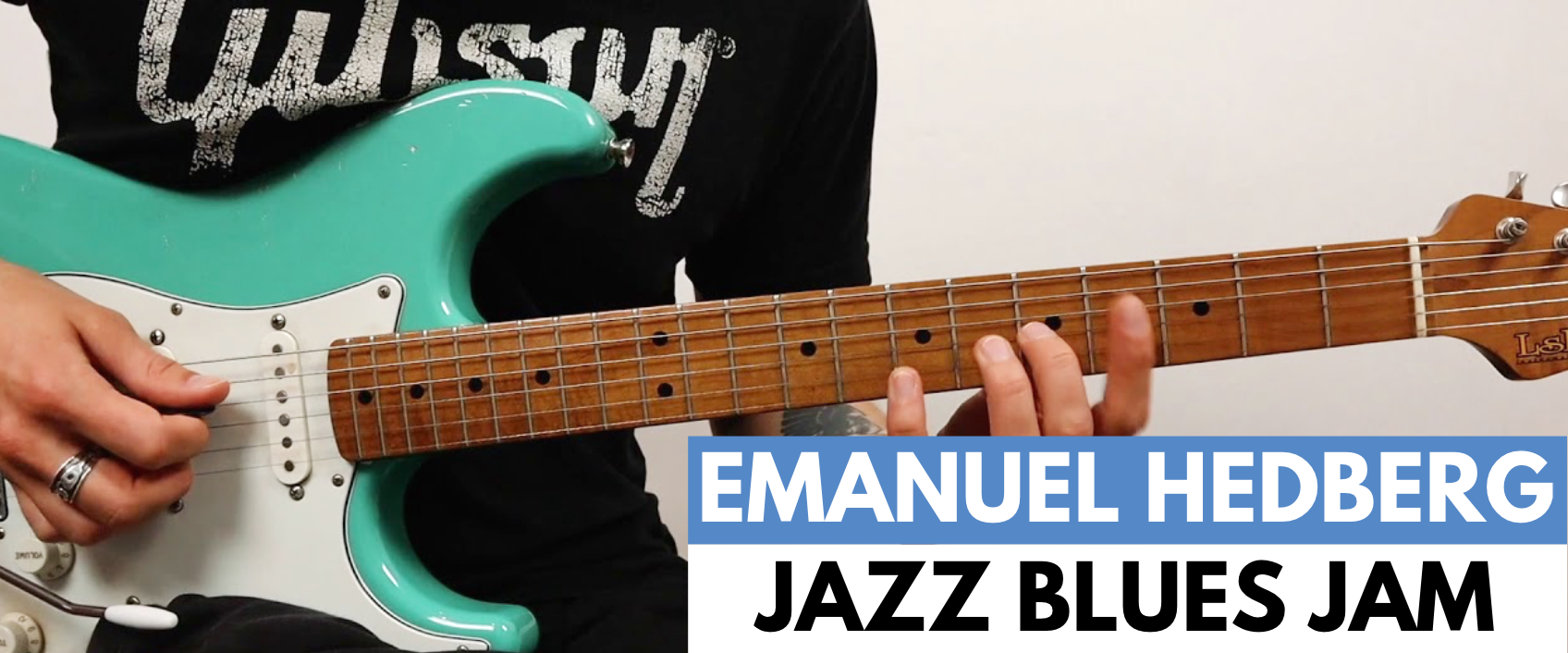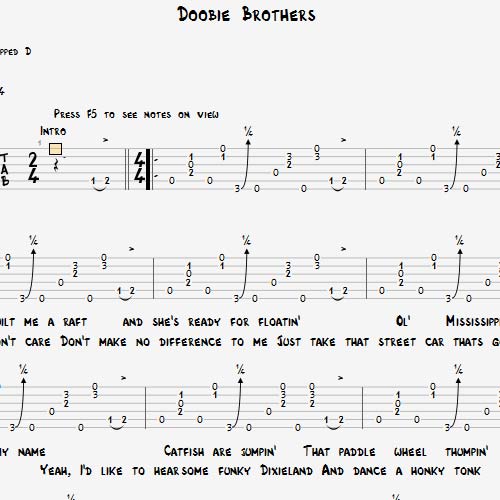When learning jazz guitar, one of the best ways to improve quickly is by playing jazz standards. By playing jazz tunes, you bring all the technical material you have studied, such as chords, scales, arpeggios, and voice leading, together and actually start playing music. Some easy songs to begin with are Autumn Leaves and Blue Bossa.
- Jazz Standards for Jazz Guitar PDF Sheet Music, TABS, Chords and Soloing with Audio Examples Welcome to our archive of some of the most popular jazz standards for jazz guitar! Here, we will provide you with lead sheets, basic chord melodies, chords and single note solos that you can begin applying over some of the most popular standards right away.
- Bb Jazz Blues Bassline A Foggy Day Bassline Bireli Lagrene.pdf All Of Me Bassline from the movie Bird.pdf All The Things You Are Bassline.pdf Autumn Leaves Basslines.pdf Jazz Blues Bassline in G.pdf Night and Day Bassline Joe Pass incomplete.pdf.
How To Read Guitar Tabs
As a new guitar player, you will need to learn how to effectively read the guitar Tab if you want to play chords, melodies, and songs. The process can get quite overwhelming, but thanks to this class, everything you need to know is well elaborated.
What's more, we are going to go the extra mile and go over the common elements you see when you pull up a tab.
The 3 Basic Numbering Systems
To fully understand how to read Tabs, you will first need to be familiar with the 3 basic numbering systems.
- Frets: These are the metal strips that lie along the neck of the guitar. Depending on your preferred hand, the pieces appear in numerical order. Starting with the first fret all the way to the last one. They will come in handy when you start learning the chords and scales.
- Fingers: From your fretting hand, your index finger is your first finger, your middle finger is your second, your ring finger is your third, and lastly, your small finger will be your fourth finger. To make the right chords, you will need to know where to place your fingers.
- Strings: The strings make the third numbering system. The lines are arranged in numerical order from the thinnest to the thickest. That is to say; the thinnest will be the first and the thickest the sixth. Pretty simple.
The Basic Layout
Now, onto the basic layout of Tabs. Let's consider a Tab you want to learn. In most cases, you will notice some standard notation on the top and bottom of the Tab. You are also likely to see six horizontal lines of the Tab that will represent the six guitar strings.
The topmost line is the high E guitar string, and the bottom line will be the low E string of the guitar. In other words, the uppermost line will be the thinnest, and the bottom-most will be the thickest.
This brings us to our first Tab tip: Always read Tab from your left to your right. In case they are all stacked on top of the other, then that is the only time you can simultaneously play multiple notes.
Notes and Chords
I have mentioned notes and chords before. So what exactly are they, and do they do?The notes are the single numbers from your right to left on a piece of Tab that will represent a melody line or perhaps a solo you might play.
The chords are the stacked numbers on a piece of tablature. They will signify a harmony of some kind.
Palm Muting and Muted Notes
Having understood the basics of a Tab layout, it is time to look into the common elements you are likely to see when trying to play your favorite song.

Palm Muting: If you can see a P.M marker, that's the palm muting. For the little dashes, those are the number of times you should continue palm muting the notes.
Jazz Guitar Youtube
Muted Notes: Also known as the dead notes, muted notes are symbolized by an 'X' on a particular string. Every time you see a muted note, you are expected to soften the note using your right or left hand. In addition, you should play the note to completely mute the pitch. This often occurs in strumming patterns or raked parts of lead lines.
Bending: Whenever you see an arrow pointing upwards, you will be expected to bend a note. The upward-pointing arrow will be next to one or more numbers. Next to the shaft, you should see an indicator showing the distance you are to bend the note. It will also be essential to mention that the bend can be 'full' or ' .'
This brings us to our next tip, which is the bending tip: A full bend means bending up an entire step. In the same context, a half bend will require you to bend up half a step.
Sliding: Hourguard time sheet for mac. remember a fret number we talked about earlier? The presentation of a fret number, a line, and another fret number will signify sliding.In most cases, depending on your sliding pitch, the line will be slanted up or down. That is to say: the line will be slanted up if you are sliding from a higher pitch and low if you are sliding from a lower pitch.
Hammer-ons and Pull-offs: you will use a little arc between two or more adjacent notes to identify hammer-ons and pull-offs. If this is a bit difficult for you to interpret, do not worry. It gets better the moment you start to familiarize yourself with a variety of musical scenarios. I'm pretty sure you will get the whole idea.
This brings us to our last tip: 'Legato' is another word used to refer to hammer-ons and pull-offs.
Vibrato: When you repeatedly bend and release note over and over, we call that a vibrato. It is used for a powerful vocal effect. With a squiggly line over a note, you can tell the intensity of the vibrato. The thicker the squiggly line is, the more intense or wide the vibrato will be. The vice-versa is also true.

Downstrokes and Upstrokes: finally, on to the downstrokes and upstrokes.Take an author of a piece of music as an example. If the composer has a specific picking pattern, you are likely to see either a squared-off upside-down ' U' or downward-facing arrow. These indicators represent the downstrokes and upstrokes, respectively. If the indicators are not included, then the player is usually free to experiment and try out his own picking patterns.
This takes us to the close of our session. As elaborated above, learning the Tab can be quite complicated, but I hope this class lifted some of the weight for you. From the class, it is also evident that practice will also come in handy to pick up all the concepts right. Otherwise, it will all just be a mystery to you. More importantly, remember to have fun and enjoy the process.
Learn from real jazz guitarists!
This site is more of a a beginner to beginner introductory wiki, where everyone can publish things that he or she might find useful gift to give to the communuity.However, jazz should be learned from accomplished jazz musicians!
So, here's some good jazz guitar educators to consider:
A behind the scenes impression of the Jimmy Bruno no nonsense approach to jazz guitar education. Some introductory free lessons at The Jimmy Bruno Guitar Workshop (JBGW)!.
Jazz Guitar Progression
—-
It's all about the ears, isn't it? Check out Willie Thomas's JazzEveryone.com in a fantastic jazz educator with revolutionary educational insights into getting into the jazz language, especially his “power of the pentatonic pairs” Best jazz ears training the is!
—-
Marc-Andre Seguin's JazzGuitarLessons.net. All free lessons by Barry Harris inspired jazz guitarist.
Barry Greene's http://www.barrygreene.com/BarryGreene.com Jazz Guitarist and Educator.
Dixon Nacey's JazzguitarLegend.com. Some introductory free lessons.
—-
Rich Stone's JazzGuitarLessons.com also inspired by Barry Harris.
Another jazz guitar great that has been inspired by Barry Harris is Roni Ben-Hur with his comprehensive and really generous chord workout DVD: Chordability - Mastering The Art of Jazz Voicings for the Guitar (2011): RoniBenHur.com. Buy it at Jamie Aebersolds jazzbooks.com!
Dr. Matt Warnock's MattWarnockGuitar.com. The video is from his “Play Better Jazz Guitar in 30 Days”.
Jazz Guitar Pro (JGP) - wiki for advancing jazz guitarists.
You'll find the content on the JGP Wiki - Guitar gadgets, list of jazz guitarist, Jazz Guitar Videos and articles in the menu and Index og Pages on the right.
The Guitaroogle bot above, is not for searching this site. It's a Custom Google Search Engine favoring several hundreds of hand picked web sites of interest to students of jazz guitar - that is, mostly sites containing lessons and other educational material, jazz guitar lessons, jazz transcriptions, links to jazz guitarists web sites, together with other types of resource. That is, sites like these:
Listen: Like Nick Carver's No Idle Fret Podcast Show.
Jazz Guitar Chord Grips & Voicings:Joe Bianco's II-V-I Tutor, a free webapp by Joe Bianco and Jeff Brent | eBook download, FREE Jazz Guitar Handbook (Complete) by Scott Baekeland. A reference source and study book for intermediate to advanced guitar players and/or teachers with a strong emphasis on Jazz Theory and stylings. It contains Chord Diagrams for all the most commonly used voicings plus many of the more advanced modern voicings.
Play-Alongs:Hal Crook Play-Alongs.
Gear: Archtop enthusiast Nicolai Foss Jazz&Archtops blog.
Lessons:StoneDragon's Online Guitar Lessons (beginner…) | chrisjuergensen.com - Lessons and Articles | JazzGuitarLessons.net | Whole Note Jazz Guitar Lessons Directory. Jeff Brent's Free Guitar Lessons Page. Joe's Guitar Method (book by Joey Goldstein). | The Jake Hertzog - Hey Jazz Guy video Lessons
Highly recommended books / DVDs: John StowellJazz Guitar Mastery | John Stowell, Mikes Master Classes | . It is said that nothing is more practical than good theory. In that respect, this guys brain is characterized by “lucid clarity” | Jay Umble
Learn Music Theory:Teoria | Hiro Honshuku's Jazz Theory Book Download.
Learn Standards: Camden Hughes Learn Jazz Standards | Ralph Patt's Jazz Vanilla Changes | All About Jazz Tunes Index | FreeJazzInstitute.org - changes | realbook.us - Jazz Chord Charts | Jazzplan.net - changes
Analysis of standards:jazzstandards.com
Jazz Vocabulary:Jim Snidero - Jazz Conception Series etudes. Matt Otto - free online lessons.
Jazz licks:bopland.org (+ some walking bass lines + and guitar comp) | jazzguitar.be various licks
Transcriptions: Jazz guitarist Steve Khan's transcriptions and original lead sheets and arrangements with the corresponding sound clips, along with an analysis. James Mahone - PRACTICE PORTAL with play-alongs. |Brent Stutzner transcriptions | Bert Ligon Jazz Transcriptions | Bruce Saunders | Emily Remler (tab) | allthingsemily.com - transcriptions(tab) | Andy Pattinson's Transcriptions | Professor Thomas Phleps Bebop Transcriptions.
Chord melody arrangements:starglasses.net - Chord melody Tabs (PDF)
Forums:The Jimmy Bruno ForumAllAboutJazz.com - Play Jazz | USENET rec.music.makers.guitar.jazz
Matt Otten - Smooth Jazz Lessons!
From Matt Ottens youtube channel:
Get the backing track on the Matt Otten Jazz Guitar site. Also check out his Matt Otten's Jazz Guitar Improvisation Exercises and Examples!

Know thy fretboard!
Comparison of the distribution of chord tones in a 2-5-1 progression. All of the chords tones, and all of the extension tones of the chords fits nicely into one and the same scale - the Ab Major Scale. Notice the relation between arpeggios and intervals of the chords, the shared notes, and the tone that sets a chords apart.
Altered dominant: Where you can superimpose pentatonic shapes over these changes? For instance, you can use F minor pentatonic over Bbm7, F# minor pentatonic over Eb7, and G minor pentatonic over Abmaj7. Then you're playing the 5, b7, 1, 9 and 11 of Bbm7; the #9, b5, #5, b7, and the b9 of Eb7; and the 7, 9, 3, #4 (the lydian sound), and the 6th over the Abmaj7.
